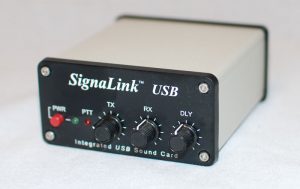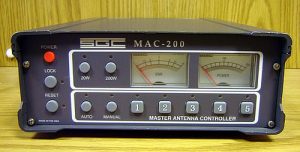

Thursday, Feb. 16, 2017 — On Tuesday I received via FedEx from DX Engineering the cable and jumper block to hook up my Signalink USB to my ICOM IC-756PRO. I have several extra Signalink’s laying around, one of which I thought needed service, but works ok. I added RMS Express and Fldigi to my PC. Fldigi gives me just about every digital format I’m interested in, and RMS Express gives me Winlink capability.
DX Engineering is a top-notch retailer; they have always exceeded my expectations every time I’ve purchased something from them, which often includes little items whose sales probably mean little to them monetariliy. I keep getting fast, superior service, and that keeps me going back to them. End of shameless plug.
For an antenna tuner here in the library I’m using a well-worn MFJ 949E. Got it worth the price on eBay, and needed some minor repairs. For more than a decade I’ve relied on Heathkit antenna tuners — the SA-2040 and the SA-2060. They’re both bulletproof tuners in my book; the 2040 is the meter-less “ugly” sister of the SA-2060. The 2060 incorporates what — to me — approximates the Heathkit 2140 dual meter SWR meter along with the bulletproof the tuner parts of the 2040.
The MFJ 949E takes a little getting used to, but it works fine. I have had the tuner dialed in on 80 for the CW net, and running about 40 or 50 watts. I wanted to tune my doublet on 40 last night, and was trying to find the sweet spot when I accidentally turned the output power to about 75 percent and transmitted; the rig display dimmed and the power supply gave a loud, low 60 Hertz modulated grunt. WTF??

I cut the output power back and completed the tuning. Then I realized why the thing was grunting … back when I was troubleshooting power supply RFI, I swapped out the 35-amp computer switching supply for a 10-amp Astron switching supply … duh! Right now I’m good with keeping the power cut back since I’m running CW and (hopefully soon) digital modes — at least until I scare up one of my 35-amp supplies.
PROPAGATION. Last night’s Georgia CW was interrupted by rapidly changing propagation as the net progressed. The NCS — over a a period of 15 minutes — gradually dropped into the noise; the more distant stations also dropped in strength; my guess is the band went very long.
Propagation is a fascinating science, one that caught my fancy back soon after I was introduced to CB radio.

My sister got married in January 1971, and soon afterward, her new father-in-law gave me an old CLR ground plane and a Hallicrafters CB-3A 8-channel transceiver. For about six months, the ground plane laid horizontally in the basement without radials between two ladder back chairs. Somehow, I heard people talking on one of my eight channels and eventually talked to some locals. In those pre-Smokey & the Bandit days, CB’er actually had licenses and many of those early adopters didn’t give second thought to giving their real names. There was none of that corn pone “good buddy” nonsense, at least in the group I talked with. Later that year, my father secured some TV tower and we got the antenna up in the air. My what a difference 25 feet can make!
While I didn’t understand propagation, I did notice how some days the “skip was rolling” and some it was not — not to mention sporadic E skip. Those I spoke with blamed the weather for most of it, and of course, I accepted it as gospel. In an effort to understand the connection between 11-meter propagation and weather, I started clipping the national weather map from the morning edition of the Louisville Courier-Journal. I would then add my propagation observations … where the skip was coming from, etc. I probably still have that notebook in storage, and I made regular observations for several months, though only when the band was open.
As you might expect, my observations found nothing concrete to connect propagation and weather. About this time I was checking out the science section of the public library, and found a late-1960s ARRL Handbook in the collection. It became my “bible” and set me on my way to getting a ham ticket (eventually). I found the antenna projects fascinating, and wondered why CB’ers didn’t build their own antennas?
SGC TUNER? Earlier today I ran across the an SGC autotuner, the MAC 200, that I purchased ages ago but never put in place. I figured my library operating position might be good place to give it a try. Initial tests so far look good, though the thing is very noisy. I just have in place testing, I don’t have the chassis grounds connected yet, and I’m getting RF into the tuner on some bands at 40-50 watts. Or it may simply be the power supply issue. If I can tolerate the racket the thing makes, I may keep it on the desk in order to continue testing it. I would like to sell somethings on eBay and I’m on the hunt for items I can liquidate. The built-in autotuner on the IC-756PRO is very quiet, but it won’t handle my balanced feedline. More experimentation ahead.
73 es CUL de KY4Z SK SK …. dit dit …
-30-
